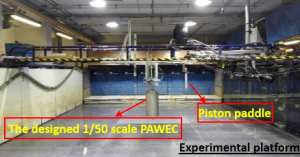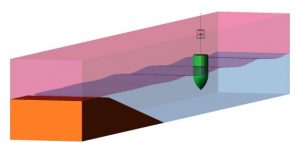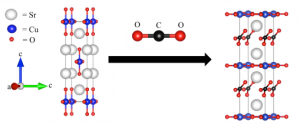About half of the HPC users at the University of Hull are PhD students, with Viper being a critical part of their research. In 2018 the University of Hull is investing in 50 PhD studentships, many of which will utilise the University’s High Performance Computing facilities. These include PhD clusters in Astrophysical Data Science; High Throughput Approaches to Decipher the Role of Human Endothelial Cells in Chronic Disease; Offshore Wind Energy Operations and Maintenance, and Molecular Stress in Changing Aquatic Environments.
Below we hear from PhD students currently using Viper as part of their studies, about their research and what impact Viper has had on their work.
Conducting Wave Energy Conversion Simulations Using Viper
Siya Jin, School of Engineering
Supervisor Professor Ron Patton
The potential wave power in global open sea has been estimated to be approximate 1013 W, which is comparable to the world’s current power consumption. Therefore, massive efforts are being made to optimise a wave energy converter (WEC) device for effective wave energy extraction.
To capture wave energy, various WEC devices have been proposed. Among these, Heaving Point Absorber Wave Energy Converter (PAWEC) is the most promising one. Siya Jin [1] on opposite page shows the experimental platform of a 1/50 scale cylindrical PAWEC system built in the Hull University wave tank. The PAWEC obtains kinetic energy by interacting with the wave. Then it drives the connected power take-off (PTO) system to generate electricity. Thus, to capture wave energy, it is of fundamental importance to study the interaction performances among the PAWEC, the wave and the PTO system.

 Figure: Physical scenario in the laboratory. The cylindrical buoy installed in the centred area is the experimental 1/50 scale PAWEC device
Figure: Physical scenario in the laboratory. The cylindrical buoy installed in the centred area is the experimental 1/50 scale PAWEC device
A series of tests has been conducted on the designed 1/50 scale PAWEC system. The tests demonstrate useful PAWEC hydrodynamics under varying wave conditions. However, due to the existence of wave reflection, while involving PTO system, it is difficult to achieve stable results. Moreover, it is interesting to understand the structure optimisation on the PAWEC performance maximisation.
Therefore, computational fluid dynamic (CFD) method (used software package, ANSYS/LS-DYNA) is applied to simulate PAWEC system. Two topics are focused (1) validation of the developed CFD model by experimental data, (2) study on the structure and PTO optimisation for power
efficiency maximisation.
To reproduce the physical wave tank, a numerical wave tank is 13 m in length, 1.5 m in width and 0.9 m both in water and air is built (see 3D NWT built in ANSYS/LS-DYNA). It takes a long computation time in my own PC for running jobs. Therefore, Viper is applied, which reduces the computation time from three days to one and a half days running with one core. Presently, our lab has purchased a license for another 4 cores for LS-DYNA. In the future, we would like to use Viper to run jobs with cores in parallel. This will improve the computation efficiency drastically. The work related to the CFD model validation and PAWEC optimisation are being prepared for journal papers and will be published soon.

Figure: 3D view of the NWT built in ANSYS/LS-DYNA. Blue, pink, brown, black and green parts are water, air, sloped beach, PTO system and optimised PAWEC device, respectively
Direct Reaction of Anion-Deficient Solids with CO2
Matthew J. Bennett, School of Mathematics and Physical Science-Chemistry
Supervisors Dr David Benoit and Dr Grazia Francesconi
Rising global temperatures are occurring as a result of man-made climate change from increasing carbon dioxide (CO2) emissions. One of the ways to reduce the amount of CO2 being released is through the utilisation of this greenhouse gas for preparing new materials. My PhD project is involved in studying the reaction of compounds with CO2 for preparing new materials, using a combination of experimental and theoretical chemistry. This is not only to find new ways of making materials with CO2, but also to try and understand the chemical reaction process-taking place. In my experiments I look at directly reacting CO2 with a variety of mixed-metal oxide based compounds, A2BO3 (A = Sr, Ca and Ba and B = Cu and Pd), to prepare oxide carbonate A2BO2(CO3) materials. My theoretical work then utilises density functional theory (DFT) methods for understanding these chemical reaction processes. This is to try and explain how CO2 reacts within these solids and form a carbonate (CO3) group.
The use of Viper allows simultaneous calculations of CO2 with solid materials to be carried out in real time. What would have taken hours to days using conventional computer systems has now been reduced to minutes. This level of high speed performance is essential in providing an in-depth study of a chemical reaction.
Through theoretical methods, a thermodynamic study of the direct reaction between CO2 and the mixed-metal oxide Sr2CuO3 for preparing Sr2CuO2(CO3) (see figure below) has been carried out. This information is essential for providing a possible reaction pathway that would be difficult to study via a purely experimental approach. At present the results from these calculations are being prepared for publication alongside the experimental values.

Figure: Sr2CuO3 (left) reacting with CO2 to prepare Sr2CuO2(CO3) (right). This reaction has been studied calculated using DFT methods within Viper
Molecular diet analysis to investigate the impacts of invasive non-native species on invertebrate communities in the UK
Marco Benucci, School of Environmental Sciences
Supervisor Dr Lori Lawson-Handley
Invasive Non-Native Species (INNS) are a massive issue worldwide. Species that get established outside of their native range end up causing drastic damages to infrastructures, biodiversity, and in some cases posing a risk to human health. The detection of damages to biodiversity, in particular those through active predation, can be challenging especially in invertebrate communities due to their elusiveness. For these cases we can now use DNA analysis and modern High-Throughput Sequencing, that allow us to generate millions of DNA strands extracted from the gut contents of individual animals to detect potential preys.
In our project we are focusing on the impacts that two invasive species in the UK are causing to the native invertebrate communities through active predation using exactly this DNA technology. In order to go from DNA to a species name we need to match each DNA we obtain against worldwide DNA databases so that we can identify each prey. This is not an easy task when we have millions of DNA reads from 100s of samples. For this intensive task we use the HPC to automatically clean our DNA information, sort them in a more manageable format, cluster them together to identify communalities and then in the end match them against the DNA database that we use as reference. All of these processes can take up to a few days per step and it can be very computational heavy; however the HPC allow us to do that efficiently, accurately and in a way that we can replicate our methods over and over again.
Currently our achievements spanned broadly from gut contents analysis of 300 individuals to description of the distribution of species into 4 water bodies, data that we can match with our data from the gut contents to cross verify presence and absence of species.
Processing and Visualisation of Graphic-Intensive Synchrotron X-ray Tomography Data
Billy Koe, School of Engineering & Computer Science and Diamond Light Source Supervisors Prof Jiawei Mi (University of Hull) and Dr Thomas Connolley (Diamond Light Source)
My research involves the studies of intermetallic particles in metallic alloys. These particles, which form when molten alloy freeze during casting, can significantly affect the properties of the cast products and anything made from the castings during subsequent processing (e.g. rolling and forging).
Typically, intermetallics have length scales from a few hundreds of micrometres to a few tens of nanometres. The understanding of how these intermetallics form is crucial in current material processing technologies. I am working with colleagues at Hull and collaborators from other research institutions on experimental studies of molten metal processing, with the aim of improving materials properties. Various molten metal processing techniques (e.g. ultrasonic treatment and applying electromagnetic fields) are being investigated as methods of refining or removing these intermetallics to enhance the properties of alloys. We use advanced synchrotron X-ray facilities in the UK and abroad to study in real-time the solidification and semi-solid processing of these alloys, using high-speed imaging and micro/nano-tomography techniques.
During the past two years of my PhD research project, I have been fortunate enough to be given multiple opportunities to carry out very advanced experiments at these facilities, which include Diamond Light Source (UK), BESSY (Germany), Swiss Light Source (Switzerland), and European Synchrotron Radiation Facility (France). The accumulated real-time datasets collected have surpassed the 10 TB mark, and this tremendous amount of data can easily overwhelm the current capabilities of a workstation due to the limited graphics, memory, and storage capabilities. These real-time datasets are able to provide novel information to further understand the underlying mechanism of how a specific alloy is formed. My usage on Viper is slightly different in nature compared to other users. I heavily rely on the visualisation aspect of Viper to study these imaging and tomography datasets. The datasets, in particular the 3D tomography scans, are extremely graphic-intensive and require a powerful graphics performance for smooth visualisation.
The figure illustrates the high resolution 3D rendering on Viper of the intermetallics (metal carbides) of a widely used INCONEL 713LC Nickel superalloy under different solidification time. With Viper, these hurdles were overcome without the need to down-sample the datasets, maintaining its high fidelity. In addition, these computing capabilities now allow us to perform full statistical analyses revealing much richer information from these datasets. This would not have been possible without the use of Viper’s HPC services. We currently have manuscripts in preparation for submission to the top material science journals.
 Figure: High resolution 3D rendering of the intermetallics (metal carbides) of a widely-used INCONEL 713LC Nickel superalloy under different solidification time
Figure: High resolution 3D rendering of the intermetallics (metal carbides) of a widely-used INCONEL 713LC Nickel superalloy under different solidification time
The Effect of Progenitor Metallicity on Nucleosynthesis in Multidimensional Type Ia Supernova Models
James Keegans, E.A. Milne Center for Astrophysics
Supervisor Dr Marco Pignatari
My research centers around providing detailed isotopic and elemental yields from a variety of astrophysical conditions. The main focus of my project is on Type Ia and core collapse supernovae, hugely powerful explosions which contribute significant material to their environments, although the suite of tools I use to investigate these can also be used in any number of astrophysical environments.
Collaborators around the world perform hydrodynamical simulations of different environments – for example tracking the shockwave which propagates through an exploding Type Ia supernova. From these simulations, temperatures and densities are extracted and used as the conditions under which nuclear reactions occur. You may well ask, why don’t these hydrodynamics models also follow nuclear reactions? The answer is a practical one – computing costs and timescales would be far too large to make this method viable. Post processing allows these problems to become tractable, and for us to provide other areas of astrophysical and nuclear research with the data they need to inform further investigation.
My work has focused on making these investigations possible, by helping to test and implement a new version of the post processing code to handle the huge numbers of particles necessary to follow the nuclear reactions happening in a supernova explosion. Currently, 100,000 different trajectories are being investigated as part of the 2 dimensional Type Ia supernova models. Once development of the code is completed we can increase this number to millions or tens of millions of particles, allowing us to investigate models in 3 dimensions. These models are the next step in providing elemental and isotopic yields to the galactic chemical evolution community, yields which have been in high demand for over a decade.
Without access to a HPC facility, and Viper in particular, this work would simply not be possible. The large number of particles to process, the time involved and the data storage requirements of this and related projects would simply be too great. Without HPC, these problems in nuclear astrophysics would remain unanswered, and other areas of physics research which rely on this information – experimental nuclear astrophysics for example – would also suffer.

Figure: Cassiopeia A, a supernova remnant. In order to accurately model the isotopic abundances from events such as this, it is necessary to consider the 3D nature of the supernova events.
Image credit: NASA/CXC/SAO

